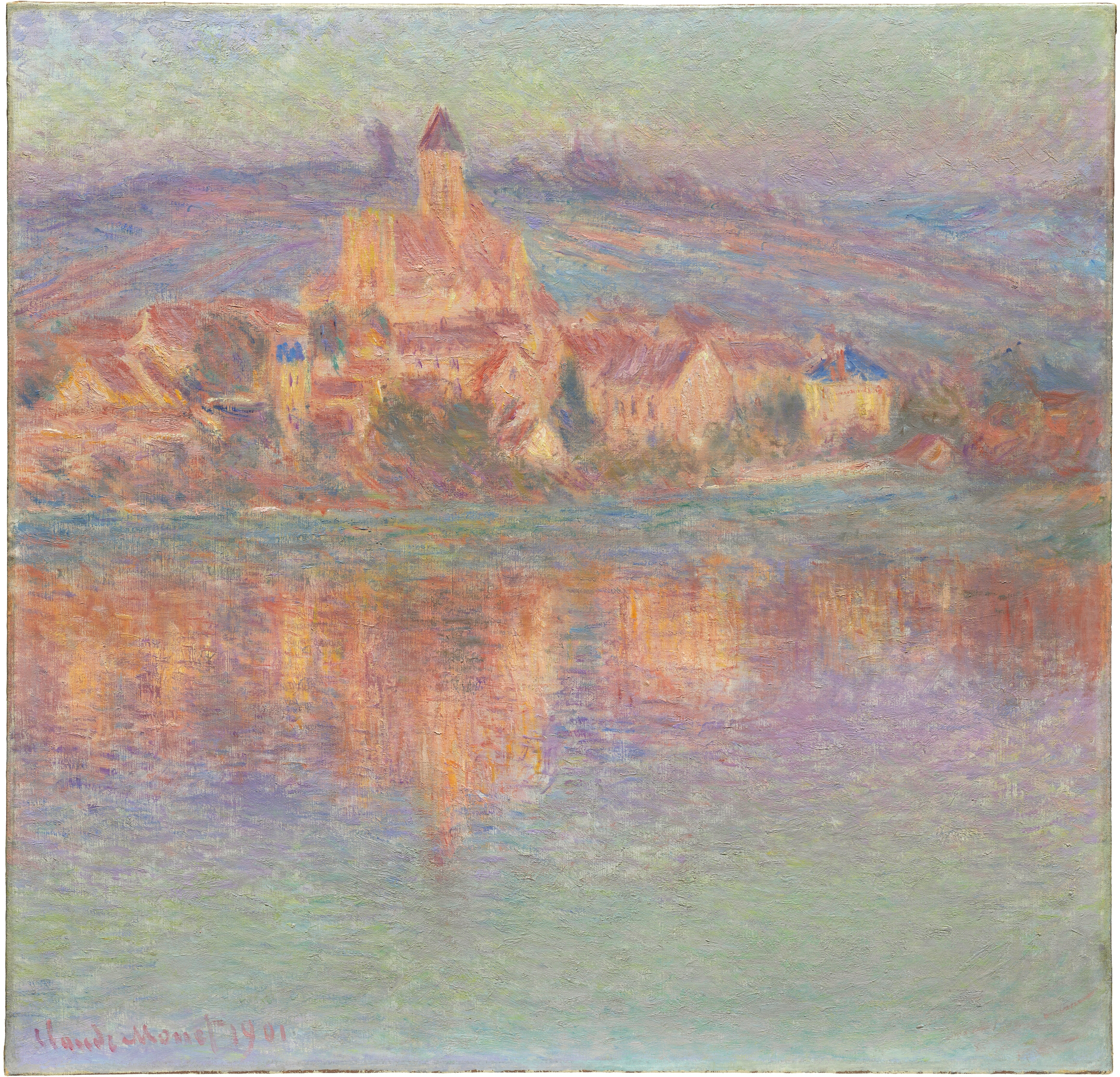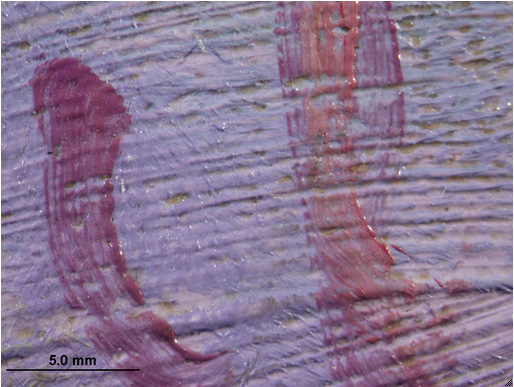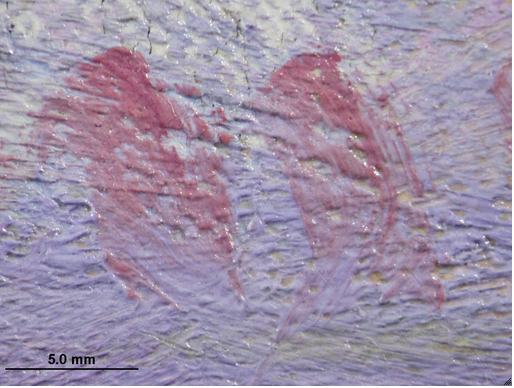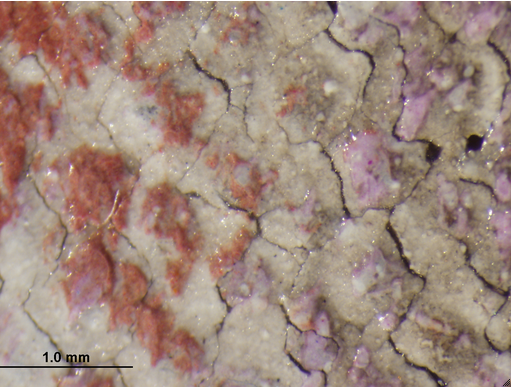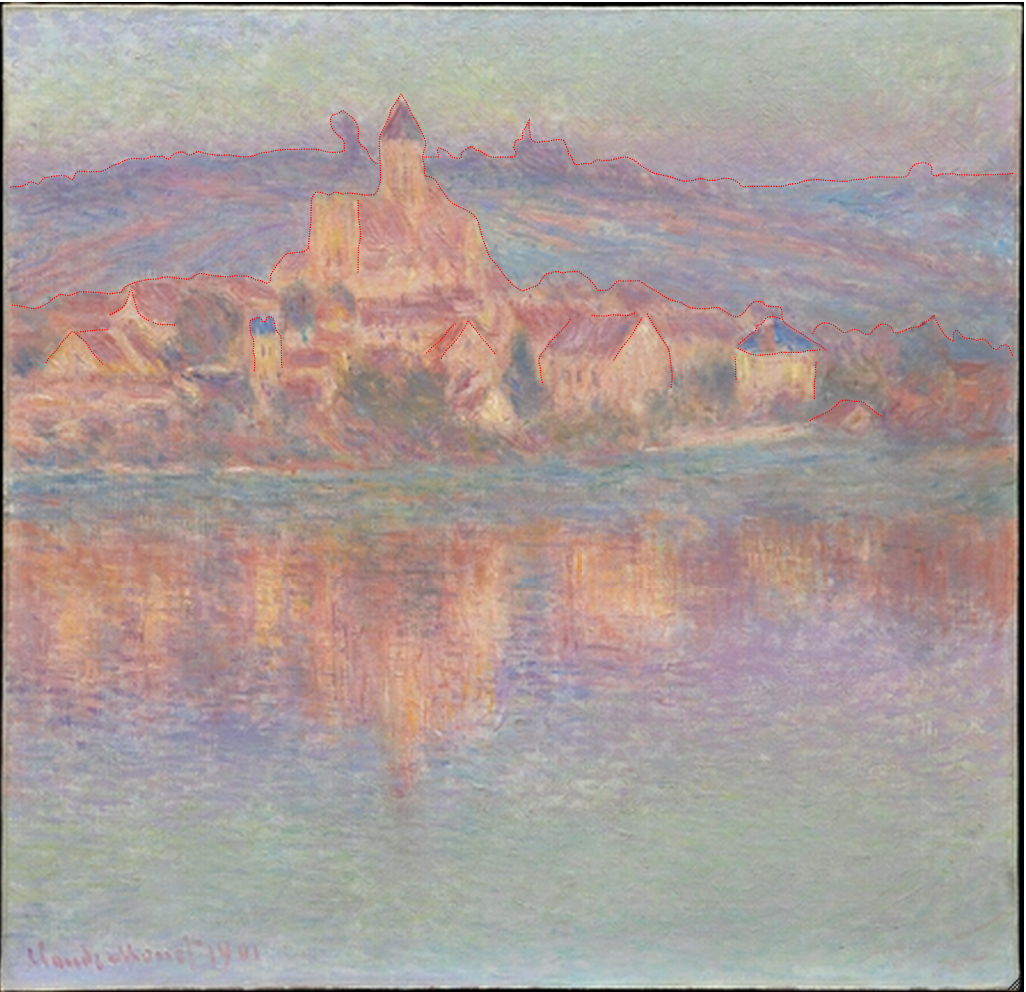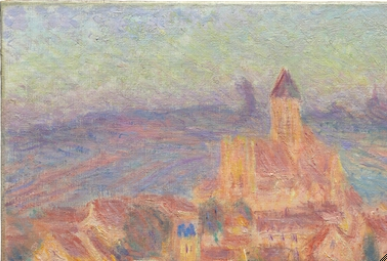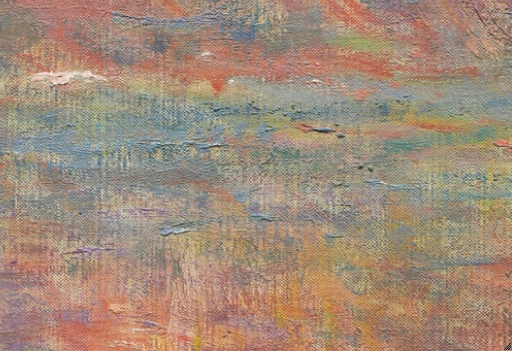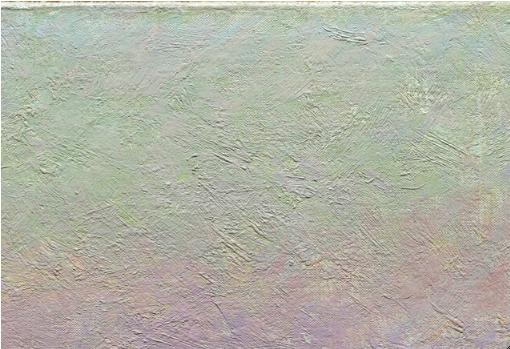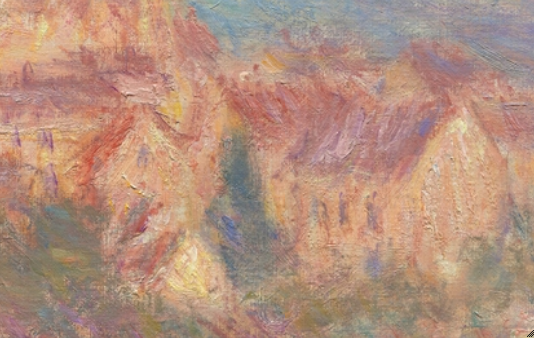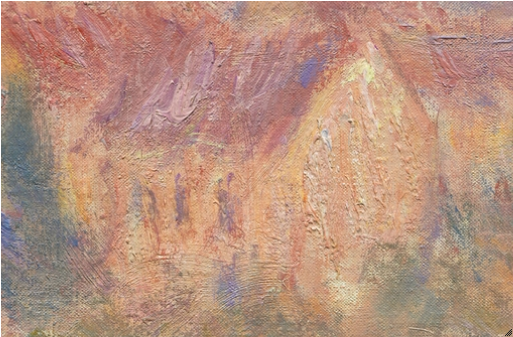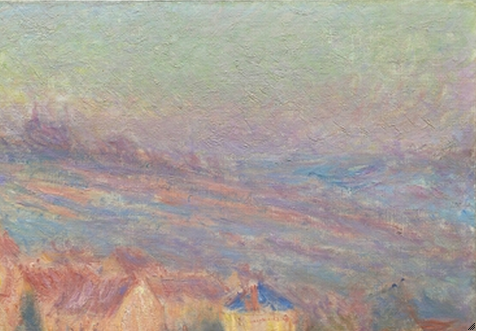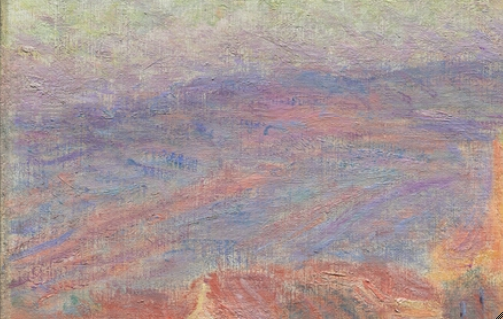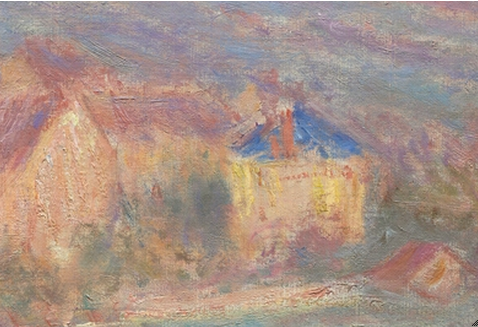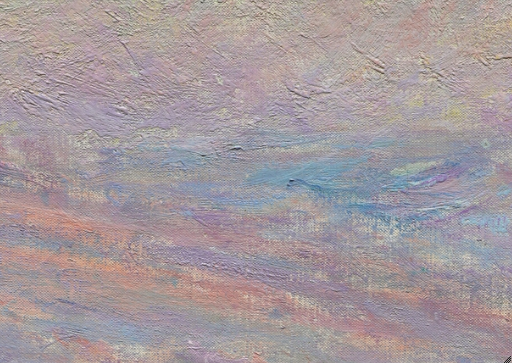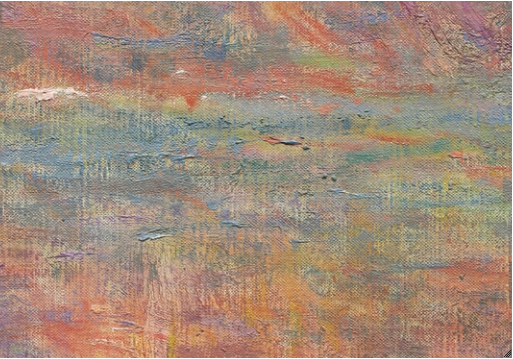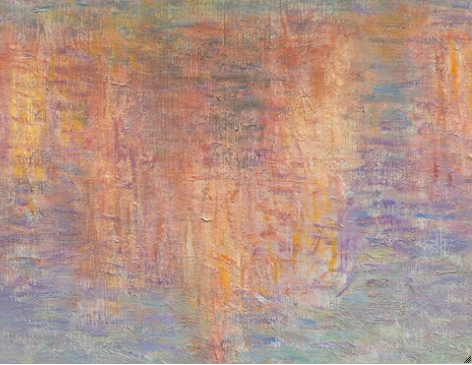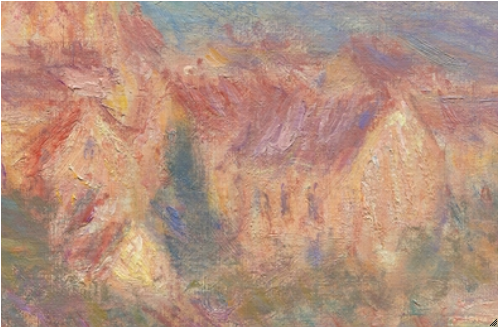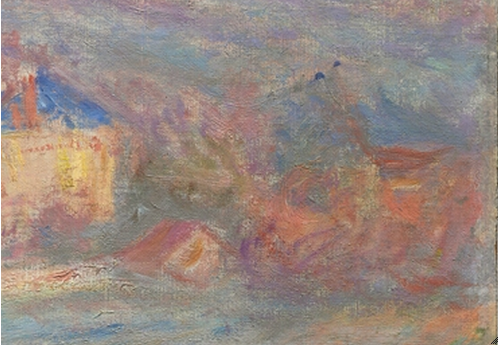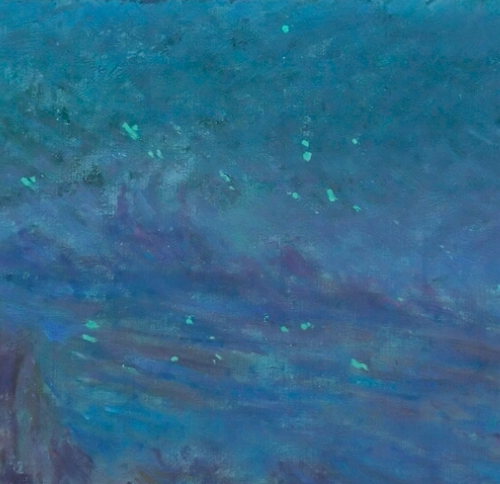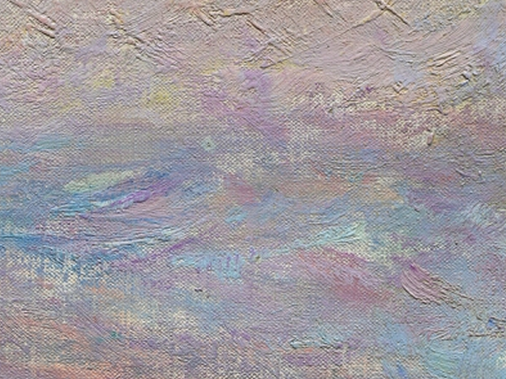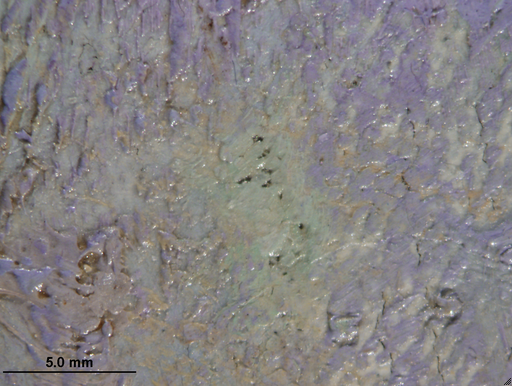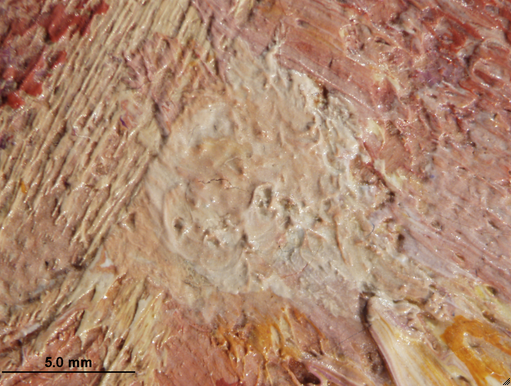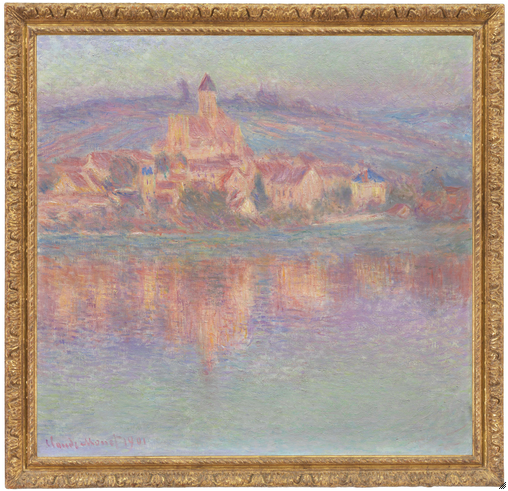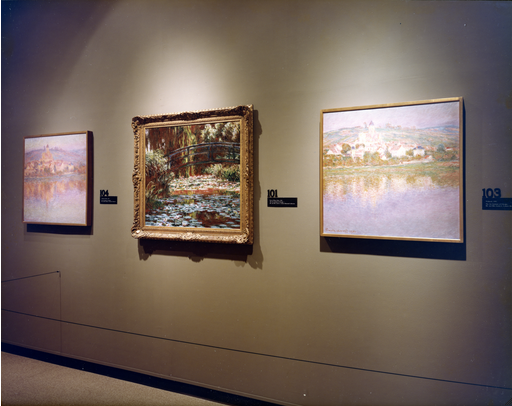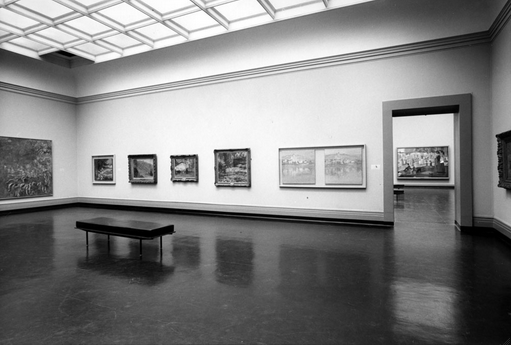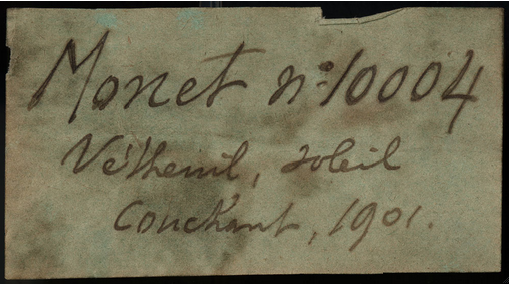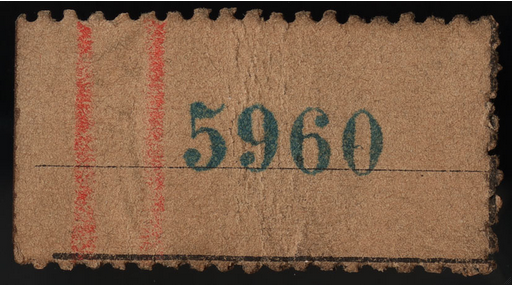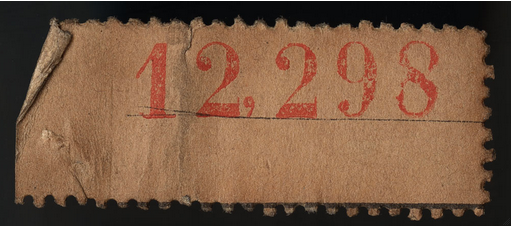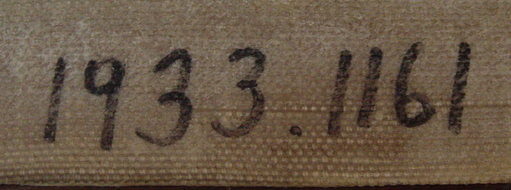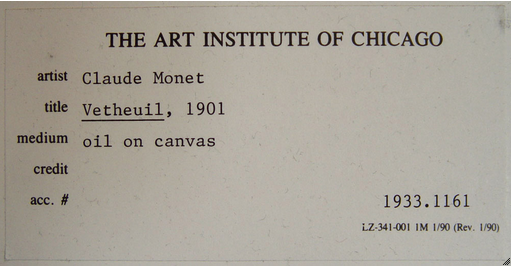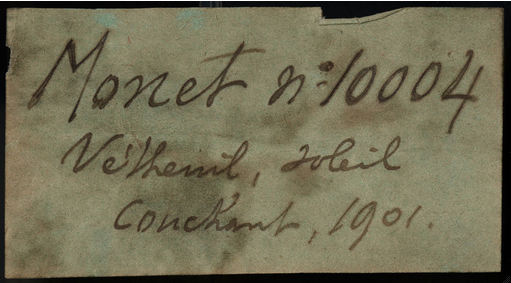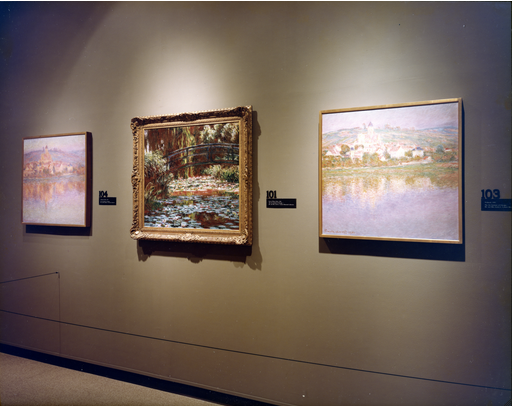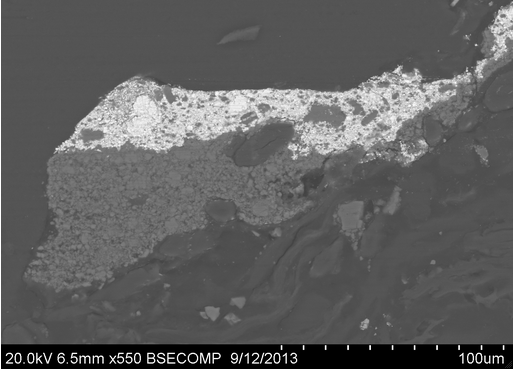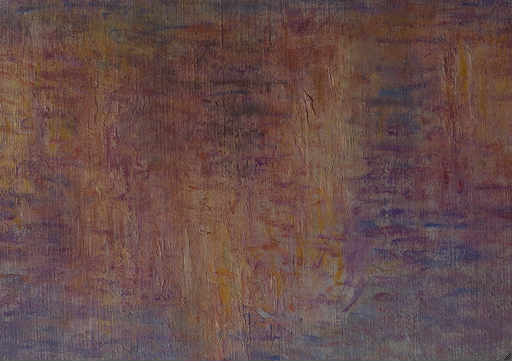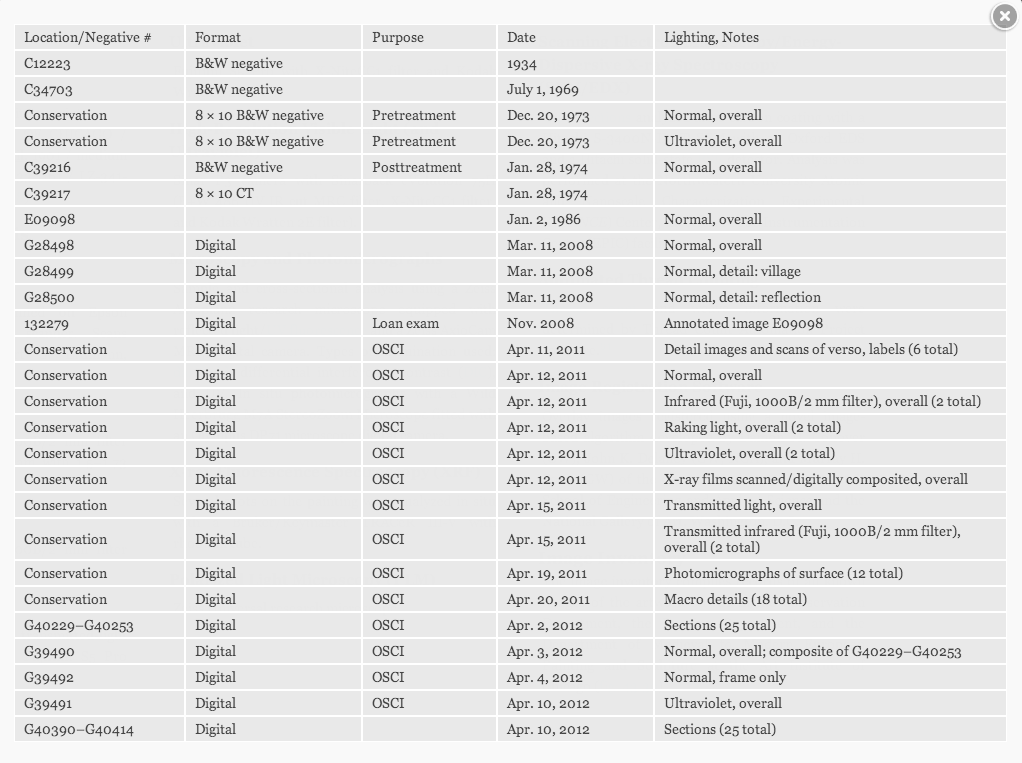Cat. 43
Vétheuil
1901
Oil on canvas; 90 × 93 cm (36 7/16 × 36 5/8 in.)
Signed and dated: Claude Monet 1901 (lower left, in in pale-pink paint)
The Art Institute of Chicago, Mr. and Mrs. Martin A. Ryerson Collection, 1933.1161
Technical Report
Technical Summary
Claude Monet’s Vétheuil was executed on a [glossary:pre-primed], non-standard-size linen [glossary:canvas]. The off-white [glossary:ground] consists of two layers. The painting was built up using a relatively open network of brushstrokes that leaves the ground layer and canvas texture visible throughout. There are no apparent changes to the composition, which was built up directly from the initial [glossary:lay-in]. Areas where the canvas [glossary:weave] remains prominent, combined with the low-relief texture of underlying brushwork and surface strokes of low [glossary:impasto], contribute varied texture to the paint surface. The work was carried out in more than one session and incorporates both [glossary:wet-over-dry] and [glossary:wet-in-wet] paint application. The generally warm [glossary:palette] and narrow tonal range used by the artist impart an overall warm, rose-colored tonality to the work. There are areas of localized abrasion and slightly flattened or pressed paint, which occurred while the painting was in progress, but it is difficult to say whether they are related to the artist’s working process or whether they were accidental occurrences. A few minor damages—tiny gouges and paint losses that occurred when the paint was still soft—were restored using a zinc white–containing paint. The [glossary:retouching] is difficult to distinguish from the original paint in some places and appears to have been applied early on.
Multilayer Interactive Image Viewer
The multilayer interactive image viewer is designed to facilitate the viewer’s exploration and comparison of the technical images (fig. 43.1).
Signature
Signed and dated: Claude Monet 1901 (lower left corner, in pale-pink paint) (fig. 43.2). The signature was started using a deeper-purple paint; the artist then went over the l a second time with a pale pink paint, which was used for the remainder of the signature and date (fig. 43.3). This paint becomes very faint in the final digits of the date; the 901 was then reinforced with a slightly thicker pale-pink paint (fig. 43.4). The underlying paint layers were dry when the signature and date were applied, except for some of the blue and purple strokes added along the bottom edge, which were picked up by the signature (fig. 43.5). These strokes may represent final touches added by the artist just before signing the painting.
Structure and Technique
Support
Canvas
Flax (commonly known as linen).
Standard format
The original dimensions were approximately 89 × 92 cm. This slightly wider than square format does not correspond to a standard size; both dimensions, however, correspond to standard stretcher-bar lengths.
Weave
[glossary:Plain weave]. Average [glossary:thread count] (standard deviation): 17.8V (0.8) × 20.0H (0.6) threads/cm; the horizontal threads were determined to correspond to the [glossary:warp] and the vertical threads to the [glossary:weft]. No weave matches were detected with other Monet paintings analyzed.
Canvas characteristics
There is mild [glossary:cusping] on all four sides of the canvas; this is slightly more pronounced along the bottom.
Stretching
Current stretching: Dates to 1974 conservation treatment (see Conservation History). Copper tacks spaced 6–8 cm apart.
Original stretching: Tack holes spaced approximately 6–8 cm apart. Additional holes interspersed between these were likely added later for reinforcement. The cusping appears to correspond to the placement of the original tacks.
Stretcher/strainer
Current stretcher: [glossary:ICA spring stretcher]. Depth: 2.8 cm.
Original stretcher: Discarded. The pre-1974-treatment [glossary:stretcher] may have been the original stretcher. It was documented as Buck type 2, six-membered, including horizontal and vertical crossbars, with keyable [glossary:mortise and tenon joints] and a beveled back face. The report gives the following dimensions: overall height, 92.5 cm; overall width, 89.0 cm; stretcher members: outside depth, 2.0 cm; width, 6.6 cm; inside depth, 1.8 cm; distance from canvas position, 1.0 cm; length of mortise, 6.6 cm.
Manufacturer’s/supplier’s marks
None observed in current examination or documented in previous examinations.
Preparatory Layers
Sizing
Not determined (probably glue).
Ground application/texture
The ground extends to the edges of all four [glossary:tacking margins], indicating that the canvas was cut from a larger piece of primed fabric, which was probably commercially prepared. [glossary:Cross-sectional analysis] indicates that the ground consists of two layers. The lower layer ranges from approximately 2 to 60 µm in thickness. The upper layer measures approximately 5 to 85 µm in thickness (fig. 43.6, fig. 43.7).
Color
Only the upper ground layer is visible when the painting surface is examined microscopically. It is off-white with some dark and possibly red or brown particles visible under magnification, as well as some larger white clusters (fig. 43.8).
Materials/composition
Analysis indicates that the lower layer contains calcium carbonate (chalk) with traces of silica and silicates. The upper layer contains lead white and calcium carbonate (chalk) with traces of iron oxide, alumina, silica, and silicates. Binder: [glossary:Oil] (estimated).
Compositional Planning/Underdrawing/Painted Sketch
Extent/character
No [glossary:underdrawing] was observed with [glossary:infrared reflectography] (IRR) or microscopic examination.
Paint Layer
Application/technique and artist’s revisions
The artist worked up the composition as a whole, moving back and forth between the different areas of the composition with no apparent revisions or changes as the painting progressed. The work was built up using a network of open brushstrokes that leaves small areas of the ground layer exposed throughout (fig. 43.9). The initial lay-in of the composition was executed with lightly applied brushstrokes using a relatively dry brush, such that the paint was deposited mainly on the peaks of the canvas weave. These areas, where the canvas texture is particularly noticeable, remain evident through the open brushwork (fig. 43.10). The vertical canvas threads appear quite prominent on the surface of the painting. In some places, this is due to random thick threads, but in other areas, the vertical threads are often emphasized by horizontal brushstrokes that caused paint to build up in the ridges along the edges of the threads (fig. 43.11). In a few areas, localized abrasion of the first thin paint layers was observed. It is unclear whether this was part of the artist’s process (i.e., intentional scraping or wiping of the paint surface) or whether it was an accident of handling, but it seems to have occurred during the painting process as subsequent paint strokes pass over the abraded areas (fig. 43.12). In the upper paint layers, some areas of thicker paint application have a slightly flattened or pressed appearance, which appears to have occurred while the paint was still slightly soft (fig. 43.13).
The surface texture of the painting includes crisp brushmarks from underlying layers, as well as thick, textural strokes and low impasto applied to the surface (fig. 43.14). While much of the surface paint layers consist of wet-in-wet applications, many of the textural strokes from the underlying layers were already surface dry when the painting was built up, indicating that the work was carried out in more than one session (fig. 43.15). The hill consists of a buildup of long directional strokes of different colors, lightly dragged across the surface of the canvas (fig. 43.16). The buildings were often delineated with a few thick, textural strokes that leave the very thin, light-handed application of the underpainting visible (fig. 43.17). In the reflected townscape, the artist laid in several long vertical strokes of textural and low-impasto paint in lighter tones of yellow and orange to denote the reflections of the buildings. These strokes appear to have been set up when the short, horizontal touches of red and purple of the water were applied on top (fig. 43.18). Overall, the palette consists of warm tones: pinks, purples, reds, oranges, and yellows for the buildings that reflect the setting sun, as well as for the reflections of the buildings and landscape in the water. The sky and water are composed of warm tones of yellowish-green and blue with some purple hues, both warm and cool. The overall tonal range is quite narrow, with little contrast between darks and lights, which helps to convey the diffuse light of the scene. The loose brushwork and subtle color transitions used in the work cause forms to blur into one another, without distinct borders, for example, between the horizon and the sky (fig. 43.19), the shoreline and the river (fig. 43.20), and the reflection and the water (fig. 43.21). The transition from one building to another is often made simply by a change in the direction of the brushstrokes or a slight shift in hue; the edges of the rooftops often remain quite sketchy (fig. 43.22). The houses and foliage on the far right of the canvas consist of an almost indistinguishable swirl of brushstrokes (fig. 43.23).
There are several small damages in the paint layer that appear to be old. They are scattered throughout the sky, the right side of the hill, the buildings on the left, and the reflection (near center). These damages, when there is associated paint loss, are visible as dark spots in the [glossary:X-ray] and, under [glossary:UV] light, retouching applied to the losses exhibits the bright greenish-yellow [glossary:fluorescence] of the zinc white used in the paint mixture (Palette) (fig. 43.24). Under magnification, the original paint in these areas appears to have been gouged when it was still soft and therefore must have occurred relatively early in the painting’s lifetime. Localized retouching consists, for the most part, of a generic pale-green paint that does not always match the adjacent original paint (fig. 43.25, fig. 43.26). The retouching appears to be old and is intimately connected with the original paint. In one place, near the peak of the roof of the building second from left, the retouching is well matched and difficult to distinguish from the original paint (fig. 43.27). This may indicate that the retouching was carried out very early on, and the possibility that Monet retouched the painting himself cannot be ruled out.
Painting tools
Brushes, including 1.0, 1.5 and 2 cm width, flat ferrule (based on width and shape of brushstrokes).
Palette
Analysis indicates the presence of the following [glossary:pigments]: lead white, cadmium yellow, chrome yellow, vermilion, red lake, viridian, cobalt blue, ultramarine blue, and cobalt violet. The presence of a pinkish-orange fluorescence indicates that the artist used red lake throughout the landscape and in the signature. Areas of retouching, which exhibit a bright-greenish-yellow fluorescence under UV light, were found to contain zinc white, and sometimes traces of barium sulfate and an iron oxide–containing pigment.
Binding media
Oil (estimated).
Surface Finish
Varnish layer/media
The painting has an even, [glossary:synthetic varnish] (see Conservation History). The surface is relatively matte, with subtle variations depending on the qualities of the underlying paint. The 1974 treatment report states that the painting previously had a discolored and yellowed, soft resin [glossary:varnish]. Its origin is unknown.
Conservation History
The pre-1974-treatment-notes state that “cleavage and flaking were present in the past and were treated locally with wax adhesive. In order to hide this treatment a piece of canvas had been placed behind the original canvas to hide the wax stains in the original canvas.”
In 1974, a yellowed varnish layer was removed. The canvas added to the back of the original canvas in a previous treatment was removed, and the original canvas was wax-resin lined. The painting was restretched on a new ICA spring stretcher. A layer of polyvinyl acetate (PVA) AYAA was applied. [glossary:Inpainting] was carried out. A layer of methacrylate resin L-46 was applied, followed by a final layer of AYAA.
Condition Summary
The painting is wax-resin lined and is stretched taut and in plane on an ICA spring stretcher. The ground layer exhibits a fine cracking pattern that follows the weave of the canvas. There is significant ground loss on the [glossary:tacking edges]. The paint layer is in good condition overall. There are a few small damages that appear to have occurred when the paint was still soft. Localized retouching associated with these damages is sometimes difficult to distinguish from the original paint and was probably added early on. It was found to contain zinc white paint. In some places, the retouching is mismatched. More recent retouching was applied almost continuously around the edges. There is some slight flattening of the impasto in localized areas, probably the result of the [glossary:lining] process. Cracking is minimal, and where present, it is mainly visible only under magnification. The painting has an even, synthetic varnish coating. Starch-paste adhesive residues from the lining procedure are visible microscopically on the surface of the painting. There are also some yellowed, [glossary:natural-resin varnish] residues in the recesses of the paint texture.
Kimberley Muir
Frame
Current frame (installed in 1991): The frame is not original to the painting. It is an American reproduction of a Louis XIII convex frame with carved alternating acanthus-leaf and flower running motif and acanthus-leaf miters, plain hollow, carved ribbon ornament and cove at the sight. The frame is water gilded over yellow-brown bole on gesso. The hollow is burnished with selective burnishing on the carved ornament. The gold has been heavily rubbed overall and toned with thin oil paint washes, casein washes, and dark flecking. The carved basswood moldings are mitered and nailed. The molding, from perimeter to interior, is ogee carved with flower and tongue; scotia side; convex face carved with alternating acanthus-leaf and flower running motif and acanthus-leaf miters; fillet; plain hollow; fillet; torus with carved ribbon; and cove at the sight (fig. 43.28).
Previous frame (installed by 1975; removed 1991): The work was previously housed in an American, mid-twentieth-century, L-shaped, narrow frame with a gilded face on a mahogany molding with exposed splines at the miters. The frame may be a design by James L. Speyer (fig. 43.29).
Previous frame: Sometime between 1956 and 1962 (based on an approximate date photograph (fig. 43.30), the work was mounted together with the Art Institute’s other version of Vétheuil in a painted shadow box. The paintings’ stretchers were mounted to the back panel of the frame with the edges of the canvas exposed. This frame was probably only utilized during this installation.
Kirk Vuillemot
Provenance
Sold by the artist to Durand-Ruel, Paris, Dec. 8, 1905, for 12,000 francs.
Sold by Durand-Ruel, Paris, to Paul Mulle de Jaegher, Roubaix, France, Nov. 8, 1911, for 20,000 francs.
Acquired by Bernheim-Jeune, Paris, by Apr. 18, 1912.
Sold by Bernheim-Jeune, Paris, to Durand-Ruel, Paris, Apr. 18, 1912, for 16,000 francs.
Sent by Durand-Ruel, Paris, to Durand-Ruel, New York (for Martin A. Ryerson, Chicago), July 31, 1914.
Bequeathed by Martin A. Ryerson (died 1932), Chicago, to the Art Institute of Chicago, 1933.
Exhibition History
Possibly Paris, Bernheim-Jeune, Oeuvres récentes de Camille Pissarro et nouvelle série de Claude Monet, Feb. 20–28, 1902, no cat. no.
Paris, Bernheim-Jeune, Oeuvres de Claude Monet, 1894–1905, Mar. 1906, no cat. no.
Barcelona, V exposición internacional de bellas artes é industrias Artisticas, Apr.–July 1907, cat. 13, under the heading Francia, as Sol poniente en Vetheuil. 25,000 francs.
Paris, Galeries Durand-Ruel, Exposition de Paysages par Claude Monet et Renoir, May 18–June 6, 1908, cat. 21, as Vétheuil au soleil couchant—1901.
Art Association of Montreal, Exposition d’art français, Jan.–Feb. 1909, cat. 241, as Vétheuil au soleil couchant.—Vétheuil by sunset.
Paris, Galeries Durand-Ruel, Tableaux par Monet, C. Pissarro, Renoir et Sisley, June 1–25, 1910, cat. 6, as Vétheuil au soleil couchant. 1901.
Leipzig, Leipziger Kunstverein, Französische Kunst der 18., 19. und 20. Jahrhunderts, Oct.–Nov. 1910, cat. 109.
Paris, Manzi, Joyant & Cie, Exposition d’art moderne, June 5–July 6, 1912, cat. 138, as Vétheuil (1901).
Zurich, Zürcher Kunsthaus, Ausstellung französischer Kunst: Bildhauerei, Malerei, Griffelkunst, Kunstgerwerbe, Feb. 16–Mar. 26, 1913, cat. 164, as Sonnenuntergang, Vétheuil, 30,000 francs.
Paris, Galeries Durand-Ruel, Tableaux par Claude Monet, Mar. 2–28, 1914, cat. 34, as Vétheuil, soleil couchant. 1901.
Art Institute of Chicago, “A Century of Progress”: Loan Exhibition of Paintings and Sculpture for 1934, June 1–Oct. 31, 1934, cat. 223.
University of Chicago, Lexington Hall, Feb. 25–Mar. 11, 1955, no cat.
University of Chicago, College of Humanities, Feb. 27–Mar. 16, 1956, no cat.
Art Institute of Chicago, The Paintings of Claude Monet, Apr. 1–June 15, 1957, no cat. no.
Art Institute of Chicago, Paintings by Monet, Mar. 15–May 11, 1975, cat. 104 (ill.). (fig. 43.31)
Albi, Musée Toulouse-Lautrec, Trésors impressionnistes du Musée de Chicago, June 27–Aug. 31, 1980, cat. 14 (ill.).
Art Institute of Chicago, Claude Monet, 1840–1926, July 22–Nov. 26, 1995, cat. 116 (ill.).
Edinburgh, Royal Scottish Academy, Monet: The Seine and the Sea, 1878–1883, Aug. 6–Oct. 26, 2003, cat. 77 (ill.).
Fort Worth, Tex., Kimbell Art Museum, The Impressionists: Master Paintings from the Art Institute of Chicago, June 29–Nov. 2, 2008, cat. 83 (ill.).
Selected References
Possibly Georges Riat, “Petites expositions: Expositions de Sisley et de MM. Monet et Camille Pissarro,” La chronique des arts et de la curiosité 8 (Feb. 22, 1902), p. 59.
Possibly Arsène Alexandre, “La vie artistique. II. Exposition Monet-Pissarro,” Le figaro, Feb. 27, 1902, p. 5.
Possibly Charles Saunier, “Gazette d’art: Monet, Pissarro, Sisley,” La revue blanche, Mar. 1, 1902, p. 385.
Possibly Edmond Pilon, “Carnet des oeuvres et des hommes, Plusieurs paysagistes” La plume, Mar. 15, 1902, pp. 411–13.
Ayuntamiento de Barcelona, V exposición internacional de bellas artes é industrias artisticas: Catálogo ilustrado, exh. cat. (Henrich, 1907), p. 53, cat. 13.
Recort de la V. exposició internacional d’art (Illustració Catalana, 1907), (ill.).
Galeries Durand-Ruel, Paris, Exposition de paysages par Claude Monet et Renoir, May 18–June 6, 1908, cat. 21.
“Échos de partout,” Le gaulois, May 20, 1908, p. 1.
Édouard Sarradin, “Notes d’art: Paysages de Cl. Monet et de Renoir,” Journal des débats, May 23, 1908 p. 3.
Gaston Varenne, “Exposition de paysages de Cl. Monet et Renoir, galerie Durand-Ruel,” L’opinion, May 30, 1908, pp. 15–16.
Léon de Saint-Valéry, “Paysages de Cl. Monet et de Renoir,” La revue des beaux-arts, May 31, 1908, p. 2.
Henri Éon, “Notes d’art. Les cent pastels. Paysages de Monet et Renoir,” Le siècle, May 31, 1908, pp. 2–3.
Art Association of Montreal, Exposition d’Art Français, exh. cat. (Henri Guiton, 1909), p. 32, cat. 241.
Léon de Saint-Valéry, “Sur quelques impressionnistes. L’expression par la lumière,” La revue des beaux-arts, June 12, 1910, p. 2.
Galeries Durand-Ruel, Tableaux par Monet, C. Pissarro, Renoir et Sisley, exh. cat. (Galeries Durand-Ruel 1910), p. 3, cat. 6.
Georges Grappe, Claude Monet (Artistique Internationale, 1911), pp. 29 (ill.), 52.
Manzi, Joyant and Cie, Exposition d’Art Moderne, exh. cat. (Manzi, Joyant and Cie, 1912), cat. 138.
Zürcher Kunsthaus, Ausstellung französischer Kunst: Bildhauerei, Malerei, Griffelkunst, Kunstgerwerbe, exh. cat. (Fritz Amberger, 1913), p. 28, cat. 164.
Galeries Durand-Ruel, Tableaux par Claude Monet, exh. cat. (Galeries Durand-Ruel/Imp. de l’Art, 1914), cat. 34.
M. C., “Monets in the Art Institute,” Bulletin of the Art Institute of Chicago 19, 2 (Feb. 1925), pp. 18–19; 20–21.
Art Institute of Chicago, A Guide to the Paintings in the Permanent Collection (Art Institute of Chicago, 1925), p. 162, cat. 2146.
Daniel Catton Rich, “Französische Impressionisten im Art Institute zu Chicago,” Pantheon: Monatsschrift für freunde und sammler der kunst 11, 3 (Mar. 1933), p. 77. Translated by C. C. H. Drechsel as “French Impressionists in the Art Institute of Chicago,” Pantheon/Cicerone (Mar. 1933), p. 18.
Art Institute of Chicago, Catalogue of “A Century of Progress”: Exhibition of Paintings and Sculpture, 1934, ed. Daniel Catton Rich, exh. cat. (Art Institute of Chicago, 1934), p. 38, cat. 223.
Lionello Venturi, Les archives de l’impressionnisme: Lettres de Renoir, Monet, Pissarro, Sisley et autres; Mémoires de Paul Durand-Ruel; Documents, vol. 2 (Durand-Ruel, 1939), p. 378.
Katharine Kuh, Art Has Many Faces: The Nature of Art Presented Visually (Harper & Bros., 1951), pp. vii; 52, pl. 83.
Art Institute of Chicago, “Homage to Claude Monet,” Art Institute of Chicago Quarterly 51, 2 (Apr. 1, 1957), p. 24.
Art Institute of Chicago,“Catalogue,” Art Institute of Chicago Quarterly 51, 2 (Apr. 1, 1957), p. 34.
Art Institute of Chicago, Paintings in the Art Institute of Chicago: A Catalogue of the Picture Collection (Art Institute of Chicago, 1961), p. 321.
A. James Speyer, “Twentieth-Century European Paintings and Sculpture,” Apollo 84, no. 55 (Sept. 1966), p. 222.
Charles C. Cunningham, Instituto de arte de Chicago, El mundo de los museos 2 (Editorial Codex, 1967), p. 11, ill. 29; 57, cat. 5 (ill.).
Grace Seiberling, “The Evolution of an Impressionist,” in Paintings by Monet, ed. Susan Wise, exh. cat. (Art Institute of Chicago, 1975), p. 35.
Susan Wise, ed., Paintings by Monet, exh. cat. (Art Institute of Chicago, 1975), p. 161, cat. 104 (ill.).
A. James Speyer and Courtney Graham Donnell, Twentieth-Century European Paintings (University of Chicago Press, 1980), pp. 12; 58, cat. 3A11; microfiche 3, no. A11 (ill.).
Musée Toulouse-Lautrec and Art Institute of Chicago, Trésors impressionnistes du Musée de Chicago, exh. cat. (Musée Toulouse-Lautrec, 1980), pp. 34, no. 14 (ill.); 67.
Daniel Wildenstein, Claude Monet: Biographie et catalogue raisonné, vol. 4, Peintures, 1899–1926 (Bibliothèque des Arts, 1985), pp. 200; 201, cat. 1645 (ill.); 359, letter 1644; 360, letters 1652a, 1653a; 369, 1789; 429, piéce justificative 236; 430, piéce justificative 267.
Andrew Forge, Monet, Artists in Focus (Art Institute of Chicago, 1995), pp. 60–61; 96, pl. 25; 109.
Charles F. Stuckey, with the assistance of Sophia Shaw, Claude Monet, 1840–1926, exh. cat. (Art Institute of Chicago/Thames & Hudson, 1995), pp. 137, cat. 116 (ill.); 235; 239; 240; 245.
Daniel Wildenstein, Monet, or The Triumph of Impressionism, cat. rais., vol. 1 (Taschen/Wildenstein Institute, 1996), pp. 354, cat. 1645 (ill.); 358.
Daniel Wildenstein, Monet: Catalogue raisonné/Werkverzeichnis, vol. 4, Nos. 1596–1983 et les grandes décorations (Taschen/Wildenstein Institute, 1996), pp. 740–41, cat. 1645 (ill.).
Michael Clarke and Richard Thomson, Monet: The Seine and the Sea, 1878–1883, exh. cat. (National Galleries of Scotland, 2003), pp. 152–53, cat. 77 (ill.).
Christie’s, New York, Impressionist and Modern Art, sale cat. (Christie’s, May 4, 2005, evening sale), p. 63, fig. 3.
Gloria Groom and Douglas Druick, with the assistance of Dorota Chudzicka and Jill Shaw, The Impressionists: Master Paintings from the Art Institute of Chicago, exh. cat. (Art Institute of Chicago/Kimbell Art Museum, 2008), pp. 161; 162; 163, cat. 83 (ill.); 167. Simultaneously published as Gloria Groom and Douglas Druick, with the assistance of Dorota Chudzicka and Jill Shaw, The Age of Impressionism at the Art Institute of Chicago (Art Institute of Chicago/Yale University Press, 2008), pp. 161; 162; 163, cat. 83 (ill.); 167.
Christie’s, New York, Impressionist/Modern, sale cat. (Christie’s, Nov. 3, 2009, evening sale), p. 61, fig. 3.
Other Documentation
Documentation from the Durand-Ruel Archives
Inventory number
Stock Durand-Ruel Paris 10004, Durand-Ruel, Paris stock book 1901–13
Inventory number
Stock Durand-Ruel Paris 8051, Durand-Ruel, Paris stock book 1901–13
Photograph number
Durand-Ruel Paris Photo 5414
Other Documents
Label (fig. 43.32)
Labels and Inscriptions
Pre-1980
Label
Location: pre-1974-treatment stretcher (discarded); preserved in conservation file
Method: handwritten script
Content: Monet no 10004 / Vétheuil, soleil / couchant, 1901. (fig. 43.33)
Label
Location: pre-1974-treatment stretcher (discarded); preserved in conservation file
Method: printed paper with stamped number
Content: 5960 (fig. 43.34)
Label
Location: pre-1974-treatment stretcher (discarded); preserved in conservation file
Method: printed paper with stamped number
Content: 12, 298 (fig. 43.35)
Label
Location: stretcher
Method: printed label
Content: I. C. A. SPRING STRETCHERS / OBERLIN, OHIO 44074 (fig. 43.36)
Number
Location: lining canvas
Method: handwritten script
Content: 1933.1161 (fig. 43.37)
Post-1980
Label
Location: [glossary:backing board]
Method: printed label with typewritten script
Content: THE ART INSTITUTE OF CHICAGO / artist Claude Monet / title Vetheuil, 1901 / medium oil on canvas / credit / acc# / 1933.1161 / LZ-341-001 1M 1/90 (Rev. 1/90) (fig. 43.38)
Examination and Analysis Techniques
X-radiography
Westinghouse X-ray unit, scanned on Epson Expressions 10000XL flatbed scanner. Scans digitally composited by Robert G. Erdmann, University of Arizona.
Infrared Reflectography
Fujifilm S5 Pro with X-Nite 1000B/2 mm filter (1.0–1.1 µm); Inframetrics Infracam with 1.5–1.73 µm filter.
Transmitted Infrared
Fujifilm S5 Pro with X-Nite 1000B/2 mm filter (1.0–1.1 µm).
Visible Light
Natural-light, raking-light, and transmitted-light overalls and macrophotography: Fujifilm S5 Pro with X-NiteCC1 filter.
Ultraviolet
Fujifilm S5 Pro with X-NiteCC1 filter and Kodak Wratten 2E filter.
High-Resolution Visible Light (and Ultraviolet)
Sinar P3 camera with Sinarback eVolution 75H (B+W 486 UV IR cut MRC filter, X-NiteCC1 filter, and Kodak Wratten 2E filter).
Microscopy and Photomicrographs
Sample and cross-sectional analysis using a Zeiss Axioplan2 research microscope equipped with reflected light/[glossary:UV fluorescence] and a Zeiss AxioCam MRc5 digital camera. Types of illumination used: [glossary:darkfield], differential interference contrast ([glossary:DIC]), and UV. In situ photomicrographs with a Wild Heerbrugg M7A StereoZoom Microscope fitted with an Olympus DP71 microscope digital camera.
X-ray Fluorescence Spectroscopy (XRF)
Several spots on the painting were analyzed in situ with a Bruker/Keymaster TRACeR III-V with rhodium tube.
Polarized Light Microscopy (PLM)
Zeiss Universal research microscope.
Scanning Electron Microscopy/Energy-Dispersive X-ray Spectroscopy (SEM/EDX)
[glossary:Cross sections] analyzed after carbon coating with a Hitachi S-3400N-II VP-SEM with an Oxford EDS and a Hitachi solid-state [glossary:BSE] detector. Analysis was performed at the Northwestern University Atomic and Nanoscale Characterization Experimental (NUANCE) Center, Electron Probe Instrumentation Center (EPIC) facility.
Automated Thread Counting
[glossary:Thread count] and weave information were determined by Thread Count Automation Project software.
Image Registration Software
Overlay images registered using a novel image-based algorithm developed by Damon M. Conover (GW), John K. Delaney (GW, NGA), and Murray H. Loew (GW) of the George Washington University’s School of Engineering and Applied Science and the National Gallery of Art, Washington, D.C.
Image Inventory
The image inventory compiles records of all known images of the artwork on file in the Conservation Department, the Imaging Department, and the Department of Medieval to Modern European Painting and Sculpture at the Art Institute of Chicago (fig. 43.39).
